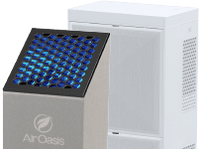Reduce Contaminants And Improve Air Quality At Home
Indoor Air Problems and Health
Due to rising energy costs, more and more Americans are sealing their homes with better windows and insulation. While the weatherization of a home does not add pollutants to the air, the reduction of outdoor air getting into a home can trap existing and new pollutants. There are many different sources of pollution in the home. Combustion sources like oil, gas, coal, kerosene, wood, building materials, furnishings, cleaning and hobby products, and central heating and cooling systems are just some of the many possible pollutant sources affecting the home. Outdoor pollutants like pollen, pesticides, radon, and smoke can also enter the home. When too many contaminants enter a home, they can pose health risks that can range from minor discomfort to severe respiratory problems. These problems can get worse with repeated or prolonged exposure. Fortunately, there are actions that can be taken to reduce contaminants in the home and improve indoor air quality.
Is an Ionizer Good for Your Health?
One of the most common questions we receive is, “Is an ionizer good for your health?” In fact, there are many health benefits that come from improving indoor air quality (IAQ) in the home and in the workplace. We often think of air pollution as being outdoors, but indoor air can also be polluted. Recent scientific evidence has shown that air within homes and other enclosed buildings is often more polluted than outdoor air in large industrialized cities. Since people spend most of their time indoors (about 90%), they are more at risk for health problems that come from pollutants. The young, elderly, and chronically ill are particularly at risk as they are most susceptible to the effects of air pollutants. Some immediate effects of poor air quality include eye, skin, and lung irritation, dizziness, fatigue, headaches, and nose and throat discomfort. These immediate effects are typically short-term and can go away by identifying the source and eliminating exposure. Long-term effects of exposure can be debilitating or even fatal and can include heart disease, respiratory diseases, and cancer. The best way to address these health risks is to identify and eliminate the sources of indoor air pollutants, even if no symptoms are present. Fresh air systems clean the air in your home by eliminating carbon-based contaminants such as dander, bacteria, viruses, and mold. These contaminants can act as allergens and trigger an allergic reaction in sensitive people. A fresh air ionizer can also reduce harmful pollutants like cigarette smoke and volatile organic compounds (VOCs).
About Our Fresh Air Systems
Our Air Sanifiers® use NASA-developed AHPCO (advanced hydrated photocatalytic oxidation) technology that has been enhanced and improved upon by our research and development team. Independent lab studies conducted at West Texas A&M University show consistent improvements in air quality, including reductions in the levels of allergens, VOCs, MRSA, bacteria, mold, and fungus. Our units are called Air Sanifiers® because they don’t just eliminate odors, but rather, they kill harmful germs, toxins, and bacteria, not just in the air but also on surfaces. In addition to our residential units, we also offer whole-house air purifiers to suit individual needs. Each unit is assembled by hand and passes a strict quality control and inspection process, ensuring optimal product reliability. We offer air purifiers backed by lifetime warranties. If you have any questions about our products before you buy, feel free to contact us.
